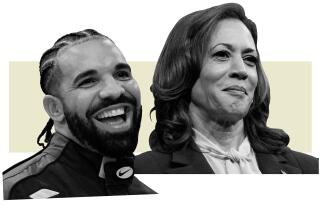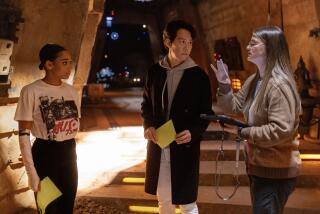A Galaxy Far, Far Off Racial Mark?
- Share via
Even before the newest entry in the “Star Wars” saga opened last week, a comic-book store clerk in Seattle had organized a group called the International Society for the Extermination of Jar Jar Binks and set up a Web site with an address that sounds like a battle cry: https://www.jarjarmustdie.com.
From all indications, the digital animated character who debuted in “Star Wars: Episode I The Phantom Menace” is irritating moviegoers across North America. A floppy-eared amphibian who speaks a Caribbean-flavored pidgin English, Jar Jar has a snout like a sea horse and an anteater’s quick darting tongue. He has been described variously as an annoying distant cousin to Disney’s character Goofy and as a racially offensive throwback to Stepin Fetchit.
“I’ve talked to 100 people and nobody likes him,” says John Hernandez, 29, a Los Angeles county worker who was among the first to see the movie. “When I came out of the theater people were talking about how annoying he was. At first I thought I was the only one, but I’ve heard it everywhere.”
Rarely has a movie character--and a glorified cartoon character at that--inspired so much vehemence. Much of the criticism centers on what some see as Jar Jar’s stereotypical racial traits. An Internet discussion group dedicated to him on deja.com had more than 13,000 postings as of Tuesday morning, many along the lines of this one: “He’s written like a character out of an Uncle Remus story, and does everything but call Qui-Gon (the Liam Neeson character) ‘Massah.’ ”
Some other Internet postings compare Jar Jar to the radio and TV characters “Amos ‘n’ Andy.” One writer says of the movie: “It could be ‘Sambo Wars.’ ”
Lynne Hale, a spokeswoman for Lucasfilm, called such interpretations “absurd.”
“There is nothing in ‘Star Wars’ that is racially motivated,” she said in a statement. “ ‘Star Wars’ is a fantasy movie set in a galaxy far, far away. It is populated with humans, aliens, creatures, droids, robots and other fantastic creatures. . . . To dissect this movie as if it has a direct reference to the world that we know today is absurd.”
Still, some people say the racial references are obvious.
Audience members have complained that Nute Gunray, the evil Viceroy of the Federation, seems based on Asian stereotypes. And Watto, young slave Anakin Skywalker’s sleazy owner, strikes some viewers as an offensive caricature of an Arab. In addition, the Gungan, the primitive tribe of which Jar Jar is a member, is ruled by a fat, buffoonish character, seemingly a caricature of a stereotypical African chieftain.
Even though Jar Jar was performed by a black actor who says he had free rein to create the character, movie reviewer Joe Morgenstern, in an essay last week in the Wall Street Journal, called Jar Jar “a Rastafarian Stepin Fetchit on platform hoofs, crossed annoyingly with Butterfly McQueen.”
The complaints call to mind the animated cartoons of the 1930s and 1940s, some of which used animal species knowingly to represent specific racial groups. (Think of the jive-talking, jazz-singing crows in Disney’s 1941 classic “Dumbo.”)
Todd Boyd, a USC cinema studies professor, says the practice continues in animation today, although in subtler form and sometimes for different purposes. Many American animated cartoons were blatantly, unrepentantly racist before their makers bowed to protests in the 1950s. Today, racial subtexts are more likely to promote brotherhood. Sometimes, though, even those cartoons skate on thin ice.
In “Who Framed Roger Rabbit” (1988) the sympathetic cartoon characters--”Toons,” they’re called, and they inhabit Toontown--were clearly treated as a racial group separate from the human race. But while the movie did not seem in any way an endorsement of racism, Boyd says he was struck by how much “Toon” sounded like “Coon,” a derogatory term used against African Americans.
“It seemed so obviously racial that I didn’t want to believe that one could get away with being so overt and not know it and have no one else pick up on it,” he says. “It was so obvious to me, and yet it wasn’t made into an issue.”
He thinks that is because non-human cartoon characters and fantastic settings can obscure the subtextual messages of movies.
“If you take ‘American History X’ and say the character’s a racist, people have no problem understanding that,” he says. “But if you were to suggest that ‘Roger Rabbit’ had issues that were problematic racially the response would probably be, ‘It’s a cartoon.’ The assumption seems to be that if something is geared for children then it couldn’t be sophisticated enough to carry those sorts of messages.”
To be sure, many viewers--particularly younger ones at whom George Lucas says the film is aimed--love these characters and see nothing offensive about them. Elliot Hartsen, a Seattle college student who saw the movie last week, said Jar Jar was “under my age bracket,” but said, “If the movie is going to generate long-term appeal it has to appeal to the young generation. These are people who will be into it when the next series comes out.”
But others leave the theater asking what was Lucas thinking.
The filmmaker is a famous cinephile who crams his films with borrowings and references to other works, from Saturday morning serials to classic westerns, from war movies to Japanese samurai films. “Phantom Menace,” far more than the earlier movies in the series, also seems to show the influence of old Disney cartoons. (It even recycles the cartoon visual gag of a big fish gobbling up a smaller one only to get swallowed by one that’s even bigger.)
Jar Jar and the other digital characters behave more or less realistically and interact with human actors in an almost seamless fashion, yet the movie could be described with little exaggeration as an elaborate, state-of-the-art cartoon featuring live action. (With three times as many computer-generated shots as any film in history, very little of this 2-hour, 12-minute movie is free of animation or digital enhancement.)
The question is whether Lucas, in rummaging through an earlier generation’s musty cartoon archives, had trouble separating what is valuable and good from outdated attitudes best left undisturbed.
Problem With Race Dates Back to First ‘Star Wars’
Grumbling about Lucas’ work has never before been this public, but some viewers have found his handling of race problematic since he released the first “Star Wars” movie in 1977. Grousers privately noted that the movie had Wookies, robots, jazz-playing aliens and--inexplicably in this far-off galaxy--white people who spoke with British accents. But nowhere on screen were there humanoids with non-pink skin.
Lucas seemed to be trying to make up for that in “The Empire Strikes Back” (1980) and “Return of the Jedi” (1983) by introducing Billy Dee Williams as Lando Calrisian. But by then his strategy was clear. Different racial groups were represented by aliens, much like those old cartoons that used animals as stand-ins for racial groups. Thus Calrisian’s race was insignificant while Chewbacca, the big, strong, over-emotional Wookie, could be seen as the hairy equivalent of Mr. T.
The frequent put-downs directed at Chewbacca underscored that, while he may be individually loved and needed, his kind was looked down upon. “I’d rather kiss a Wookie,” Princess Leia spits when Han Solo gets flirtatious. “He’s only a Wookie,” C-3P0 says of Chewbacca in “Empire,” even while being carried on the Wookie’s back.
In an interview with Leonard Maltin on the digitally mastered video of “Return of the Jedi,” Lucas says he’d originally intended to introduce Wookies as a “primitive race” in the third film of the trilogy. After he decided to use Chewbacca in all three films and give him the ability to fly spaceships and perform complex tasks, he created a substitute race of pint-sized Wookies for “Jedi” and called them Ewoks.
The Gungan are the Ewoks of “Phantom Menace.” This tribe of incompetent but happy natives with their vainglorious leader comes straight out of the movies and cartoons of another era. That the Ewoks and the Gungan both save the day and that both movies end with the advanced and primitive races joined together in harmony is of little consequence; it’s clear who holds the upper hand. “Dumbo’s” crows save the day, too (and sing that movie’s most infectious song to boot), but by using exaggerated stereotypes the cartoon’s creators still indefensibly hold a race of people up to ridicule
and perpetuate attitudes that permeated the culture in the 1940s.
All of this said, it should be noted that many of the people who detest the character of Jar Jar say it has nothing to do with race. One Internet user observed: “He is the worst character in ‘Star Wars’ history, a pathetic excuse to sell toys.”
Jeremy Mueller, the 23-year-old who founded the International Society for the Extermination of Jar Jar Binks, says that he started his jarjarmustdie.com Web site five days before “Phantom Menace” opened when he saw television shows about the movie that gave a flavor of what the character would be like.
“They were quoting lines from the movie, including, ‘Oh, da force is maxi big,’ ” he says. And on the back of the Jar Jar action figure, he says, were lines that the character utters: “Mesa called Ja Ja Binks.”
“How can you like a character like that?” Mueller asks. “It’s a great movie, but Jar Jar really detracted from the movie as a whole.”
More to Read
Only good movies
Get the Indie Focus newsletter, Mark Olsen's weekly guide to the world of cinema.
You may occasionally receive promotional content from the Los Angeles Times.










